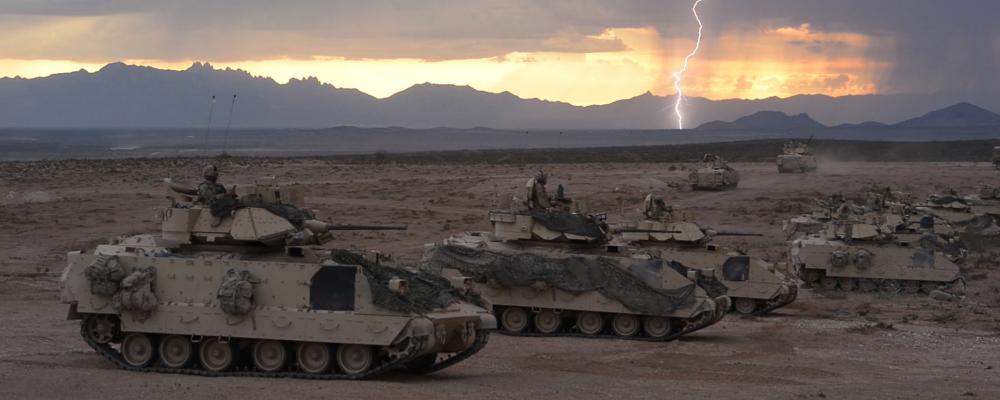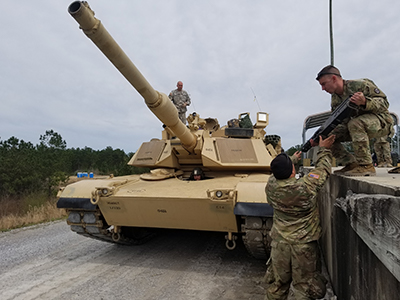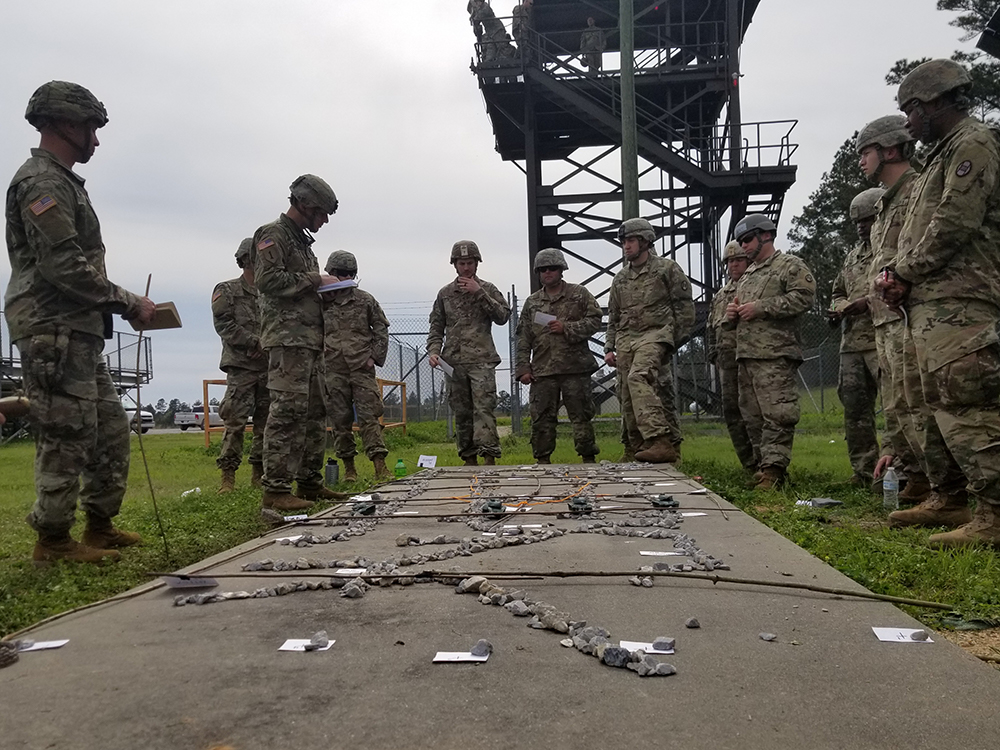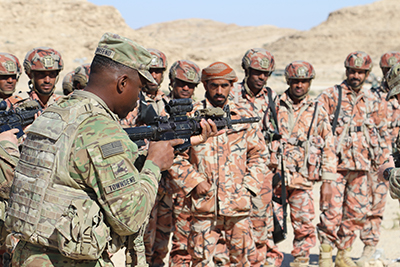
The bus carrying members of the 30th Armored Brigade Combat Team traveled nearly 800 miles from North Carolina by the time it reached this sprawling training post in southcentral Mississippi.
It arrived in the middle of the night. But the soldiers had little time to spare. “By 6 a.m., we were working,” said Sgt. Jake Anfinson during the March training exercise, which spanned parts of two weeks. “It’s been 24/7 ever since.”

Drew Brooks
Anfinson was one of 10 maintainers attached to the brigade’s B Company, 1st Battalion, 252nd Armor, during the gunnery exercise.
Day and night, the soldiers worked to keep the unit’s old M1A1 AIM-SA Abrams tanks running.
“It’s not like working on your car. It’s more complicated,” said Sgt. Daniel Loflin. “Four tanks went down on the first day. It’s been nonstop since then.”
Nonstop is becoming the norm for the brigade, at least as it prepares for a deployment to the Middle East later this year as part of Operation Spartan Shield.
These soldiers scoff at the notion of “one weekend a month, two weeks a year” — the old adage that long applied to Guard service.
That model, in which Guard troops could expect 39 training days a year, has been long outdated.
Under a sustained readiness model, also known at Army National Guard 4.0, most members of the brigade trained more than 80 days last year. This year, between training and mobilization, they expect to be with their unit for well over half of the year — up to 200 days for some.
The increased training days will help prepare the brigade — which also includes formations from South Carolina and West Virginia — for its coming mission. But there are tradeoffs.
Civilian careers and education have been put on hold. Others are struggling to balance civilian work, service commitments and family responsibilities.
This is the new normal for high-priority units, such as the Guard’s armored brigade combat teams. The Guard has five ABCTs, which constitute about one-third of the Army’s tank force. Not long ago, the Guard had seven. With the National Defense Strategy’s emphasis on great-power competition, those that remain are now in high demand.
The 155th ABCT, based in Mississippi, returned from a 9-month deployment in support of Operation Spartan Shield in March. Elements of the 278th Armored Cavalry Regiment, based in Tennessee, deployed to Poland and Ukraine last year as part of a deterrence mission. The 278th relinquished authority of those missions to an active-component unit May 2 in preparation of coming home.
The 30th ABCT is next in line for the Guard. Following an exercise at the National Training Center (NTC) in California this summer, they are slated to mobilize and eventually replace the active-component’s 3rd ABCT, 4th Infantry Division, which followed the 155th in the Kuwait-based mission earlier this year.
Since officials announced the initiative in 2017, Army National Guard 4.0 has accelerated the training tempo for armor and Stryker brigade combat teams, as well as attack-reconnaissance aviation battalions and other “high-priority” units.
“Last year we did the math. The average soldier in the company [served] about 90 days.”
—Capt. Sean Bolick, Commander, B Company, 1st Battalion, 252nd Armor, North Carolina Army National Guard
Under the old deployment model, most units would be alerted for a deployment roughly 18 months ahead of their mission and would ramp up training for that specific undertaking.
Now, those units can expect a steady multiyear training cycle that builds on collective unit tasks and decisive-action environments, culminating in a rotation at either NTC or the Joint Readiness Training Center in Louisiana.
The goal is for units to be able to deploy rapidly in response to a contingency operation or rotational deployment at the end of each cycle, during what is known as their “ready year.”
More concisely, it’s about reducing post-mobilization time to be faster to the fight, Guard officials say.
“We are implementing this transformation because our country needs us to do so,” said the former Army Guard director, Lt. Gen. Timothy Kadavy, last year. “This is due to the current size of the Total Army and the multiple threats that our country faces from potential adversaries.”

Drew Brooks
As the Guard implements its new training tempo, armored brigades are learning from each other while developing best practices for how to cope with the increased requirements.
Col. Robert Ferguson, the commander of the 155th ABCT, invited the 30th ABCT commander, Col. Robert Bumgardner, and his staff to Kuwait earlier this year. He also recently spoke to 30th ABCT leaders during a mobilization workshop at Fort Bliss, Texas.
His message: “We’ve got to live and eat and breath and view these deployments in a current mindset, not a 2005 mindset.”
If not, he says the Guard risks chasing traditional Guardsmen out of the force, especially valuable mid-termers, those who have nine to 15 years of service and fill essential leadership roles as officers and noncommissioned officers.
“We lose them not because it’s hard, but because they are forced to make a decision at one time or another,” Ferguson says. “It’s the Guard versus mid-management roles in their civilian careers. It’s a hard decision.”
Ferguson is a traditional Guardsman. He’s a high school English teacher in the DeSoto County School District. But he’s had to put that career on hold for the Guard.
“I haven’t been to my civilian job in two years,” he says.
Others in the brigade have had a similar experience. Students have taken time off from school. Some returned from the deployment to learn that their jobs no longer exist.
“We must find a way to keep those essential soldier leaders,” Ferguson says. “If not, we’re starting from scratch each time. We’ve got to be smart enough to keep them.”
The 30th ABCT began to see an increased training tempo shortly after the unit returned from its last deployment, to Kosovo as part of a peacekeeping mission, in 2016.
The number of training days have steadily increased each year since then, said Capt. Sean Bolick, the state’s individual-training manager and the commander of B Company, 1st Battalion, 252nd Armor, while at Camp Shelby.
Much of the added training time has been invested into the building blocks of readiness for a tank unit — improving cohesion among the four-soldier crews that man each tank and then gradually introducing more complex scenarios that require a larger force.
“Last year we did the math,” he said. “The average soldier in the company had about 90 days.”
That includes a nearly month-long exercise at Fort Bliss, as well as training at nearby Fort Bragg and Fort Pickett in Virginia.
Two-day drill weekends have been stretched to three, four or five days, he said. And soldiers being out in the field for weeks at a time, multiple times a year, has become the norm.
“It’s tough sometimes,” said Spc. Philip Hill, who was part of the best tank crew in the Army in 2016, when the 30th ABCT claimed the Sullivan Cup following a competition alongside active-component tank crews.
“You promise the National Guard two weeks out of the year,” he said, referring to the tradition training schedule. “When that’s more, my family always supports me. My job, though. It’s been difficult. They’re working with me.”
Hill, a police officer in his civilian job, is not alone. Other soldiers in the 30th ABCT have taken the year off from school. Some have been asked to choose between their military service and promotions in their civilian jobs.
“It gets tough at times and you have to make hard decisions,” Bolick added. “It happens at all levels within the organization. Most of our soldiers like being soldiers. They understand what we signed up for.
We’ve got a lot of guys that have been around for a while, they’ve done this multiple times for multiple deployments. They understand it. But it doesn’t make it any easier the more you’ve done it.”
The brigade has tried to provide soldiers, families and employers as much lead time as possible for training events. It has also accommodated in other ways. For example, in August leaders sent a group of soldiers who were teachers and college students home early from an
Exportable Combat Training Capability (XCTC) exercise training at Fort Bliss, Texas, so they could start the new school year on time.
Those efforts have gone a long way to helping to open the eyes of families and employers, Bolick said. The brigade also invited employers and others to view training firsthand, to see what happens when a soldier is not at his civilian job.

Spc. Linsey Williams
Ferguson, the 155th commander, believes more can be done to ease the added burdens of an increased training cycle.
“There are three partners that make the relationship work,” he says. “Soldiers, family and employers.”
Soldiers and families benefit through added pay or health care, Ferguson says. But “there’s nothing in place for employers.”
Ferguson notes that legislation currently in Congress, the Reserve Component Employer Incentive, Compensation, and Relief Act of 2019, would give employers a tax credit for Guard employees who are called away for their military service.
“We will lose soldiers if we’re not smart,” he says. “We’ve got to make the employers happy, too. That’s what we need.”
Guard leaders in Washington are aware of the concerns. Gen. Joseph L. Lengyel, the chief of the National Guard Bureau, has said the new training model will force changes to the force.
Speaking at a forum last year, he acknowledged that some Guardsmen may not be able to tolerate the increased training.
“The trick for us is to see how are we going to be able to do this in cycle two and three and beyond,” he said. “Is this sustainable? We tend to think it is, but I predict there will be some changes.”
One change Lengyel would like to see is more Army Guard fulltime support. That would enable part-time Guardsmen to focus more on training.
At Camp Shelby, Bolick had the added task of integrating several new soldiers into the unit.
The experienced tank crews that existed two years ago have been broken up. The junior soldiers on those crews are now leaders on new tanks.
Hill was a driver on the 2016 Sullivan Cup crew. Now he’s a gunner, filling a position — along with tank commander — that Bolick describes as a “lynchpin” for success within the tank.
“It’s very important to have a good crew,” Hill says. “Your crew is your family. We’re all a team here. Everybody’s important.”
Despite the added challenges, he says the additional training is paying off. “It’s actually going really well.”
The company is authorized 62 soldiers, but had as many as 90 troops on the ground in Mississippi. That included 20 “green” privates that were either fresh out of basic training or transferred from other units across the state. Many had yet to attend armor school.
“For some, it’s their first time in tanks,” Bolick said. “Last month, they were truck drivers. They’re new to the unit and new to tanks.”
“The trick for us is to see how are we going to be able to do this in cycle two and three and beyond.”
—Gen. Joseph L. Lengyel, Chief, National Guard Bureau
Staff Sgt. Robert Melvin, the company’s readiness noncommissioned officer, said the unit will likely be closer to its authorized strength by the time it deploys, as medical issues and other problems will keep some from deploying.
He believes the more demanding tempo has driven out some of the company’s more experienced soldiers. “We have progressively gotten younger,” he said.
Melvin noted that some troops have essentially worked half a year without added benefits, such as health care. The troops will not get TRICARE medical coverage until closer to their mobilization date.
Until then, some “not on the upper end of the financial spectrum” will opt not to take care of nagging medical issues due to the cost.
Ferguson says that challenge is unavoidable.
At the peak of the 155th’s deployment, the brigade had about 4,300 soldiers, he says. But the unit’s largest battalion was always its rear detachment, which included 1,000 personnel who were potentially being moved out of the Guard due to medical issues.
Ferguson says the Guard is held to higher standards of medical readiness than active-component units. And, unlike active brigades, the 155th can’t rely on the support of sister brigades to fill its manpower. Instead, the unit had to backfill with soldiers who were involuntarily added.
“There are days that are frustrating,” Ferguson says. “Not everyone wants to wear this patch. There are days I don’t want to wear this patch. But the soldiers who do this — 80% of them want to be here.
They want the hard jobs. They want to be in the Guard brigade that has the mission of what we do.”
MANY of the challenges at Camp Shelby had nothing to do with personnel, but were instead related to the notoriously finicky tanks themselves.
The company has 14 of the M1A1 AIM SA tanks. Following training at XCTC in August, fewer than half were sent home to Fort Bragg while the others were sent to Camp Shelby.
The tanks are older models than those used by most of the Army.
And officials say the older tanks will be what the unit takes with them to the Middle East later this year.
While the 155th used pre-positioned tanks for its mission, the 30th opted to use their own tanks, allowing the unit to “train like it fights” instead of having to adapt to a more modern weapon system while deployed.
Loflin said the tanks at Camp Shelby are the best the unit has, but aren’t without their issues.
“They’re 20-year-old tanks that don’t just sit in a motor pool.
They get used,” Loflin said. “We’re training every month. Maintaining them is very in-depth.”
The unit has been further stressed by a series of natural disasters that have struck North
Carolina in recent years.
Melvin lost his home during Hurricane Matthew in 2016. And like many of the brigade’s soldiers, he volunteered to be part of the weeks-long response to Hurricane Florence last year, even as the hurricane struck while the unit was returning from training in Texas.
“I landed and never went home, I went straight into hurricane duty,” Melvin said.
But Melvin says the unit will find a way to overcome any challenges it faces ahead of the deployment.
“We have never not met the mission,” he said.
Our Take
The additional demands placed on Guard armored brigade combat teams and other “high-priority” units have not come with any attempt to ease the added burden on soldiers, their families or their employers.
A good place to start would be to eliminate the monthly premiums on TRICARE Reserve Select. TRS premiums are only $50 a month, a bargain for medical coverage. Yet one in five Guardsmen have no health coverage. Providing TRICARE coverage to part-time Guardsmen would likely pay for itself in higher medical readiness and retention rates. It could also help reduce employer health care costs. Another benefit to employers would be tax credits for productivity lost due to Guard and Reserve training or operations. A bill in the House, the Reserve Component Employer Incentive, Compensation, and Relief Act of 2019 (H.R. 8010), would provide employers with a $1,000 credit for every Guardsman or Reservist on the payroll plus an additional amount based on the days of service during that taxable year up to $10,000 for 180 or more days of service. Tax credits are a NGAUS legislative priority this year.
High-priority units would also benefit from greater full-time support, another association legislative priority. Army Guard has a FTS level that is only 16% of its personnel, the lowest
among the seven reserve components.
